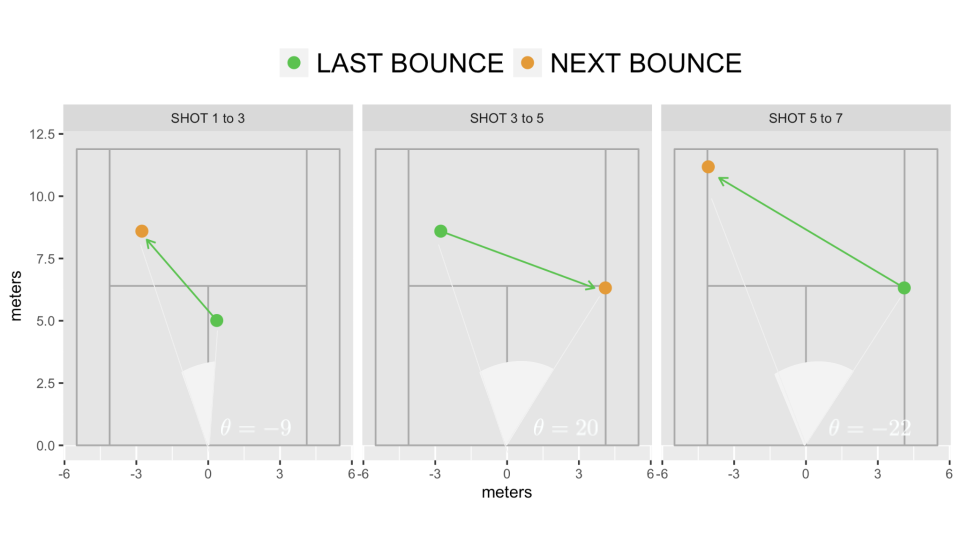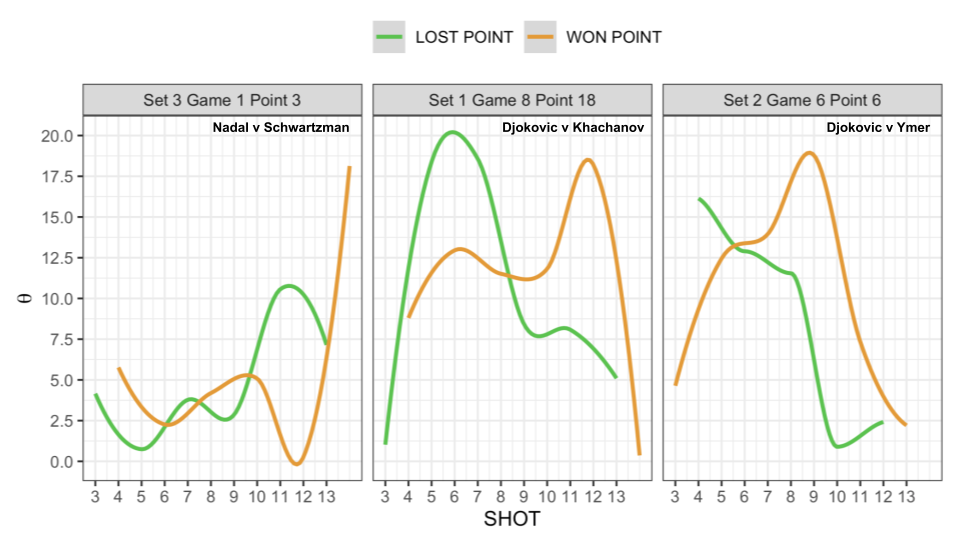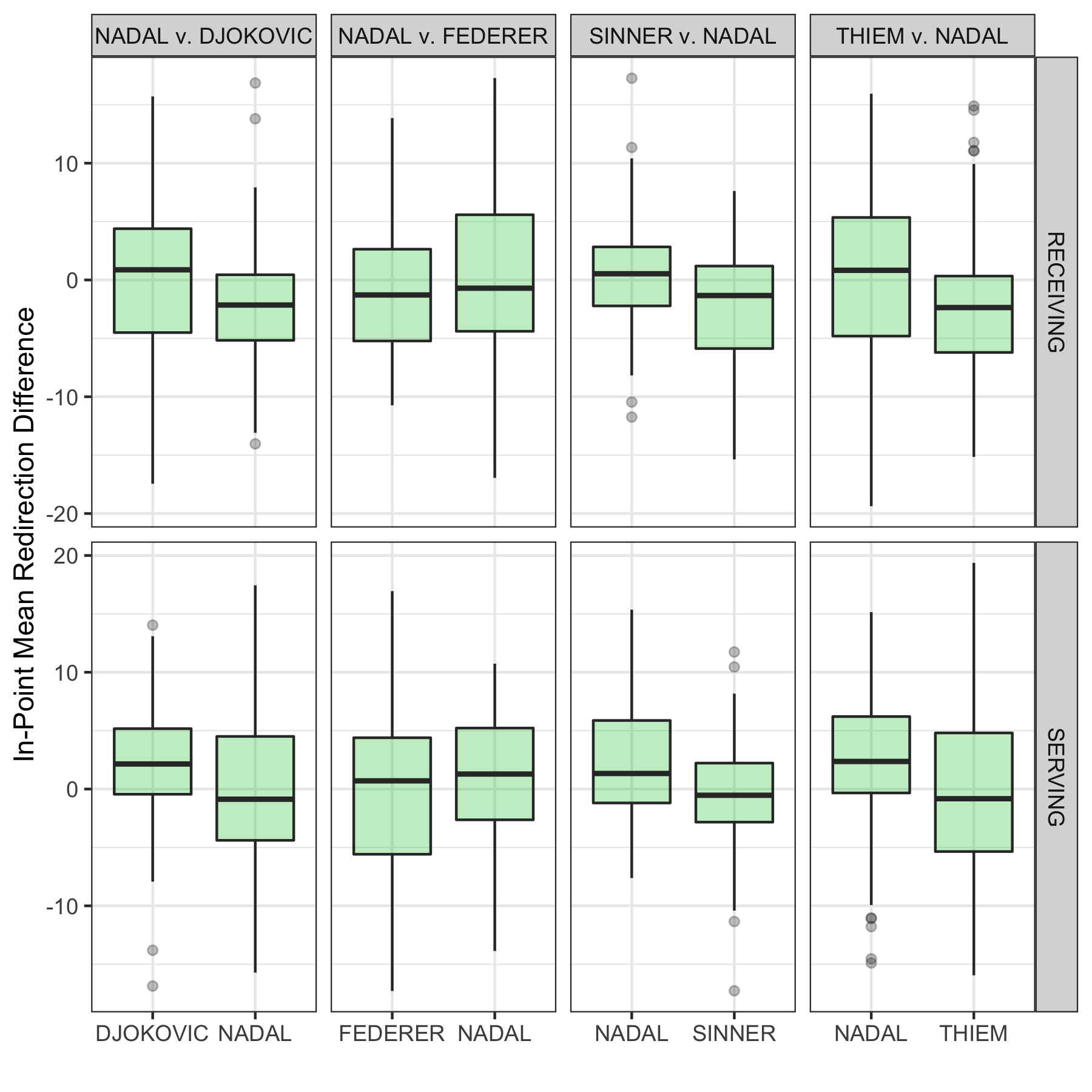A Stat for Change of Direction
Change of direction is the skill of moving the ball from one side of the court to the other. Being able to control the direction of the ball during a tennis point can be a key strategy for forcing an opponent out of a comfortable position and setting up a winning shot. With modern tracking data, where the trajectory of every shot in a point is known, we can begin to investigate how change of direction is best quantified. This post is a collection of some initial ideas on a statistic for change of direction.
In “What Tennis Pros Don’t Teach”, high-performance coach Manuel Cervantes says that ‘Redirecting the ball is crucial to tactical success in general on a tennis court whether we are playing singles or doubles’1. Given the importance of changing the ball direction for success in tennis, it is surprising that there is so little information about the type and frequency of redirection in the pro game.
With the detailed information tracking systems, like Hawk-eye, capture about tennis shots, measuring redirection should be straight-forward. Although most of that data is beyond the reach of tennis researchers, some glimpses of it have recently become available on the websites of some of the Grand Slams, namely, Roland Garros. Behind the Infosys courtvision web applet are trajectory summaries that include up to four points of the ball’s position for every shot. That’s an ample playground for exploring change of direction.
So where do we get started? It might help to ground our thinking by first breaking down a rally in detail. Let’s consider one of the points from the 2020 RG men’s final. That match is probably best remembered for how quickly it got away from World No. 1 Novak Djokovic. But even after being bageled in the first set, Djokovic was still able to show flashes of his best game at times, as we can see from this point early in the 2nd set.
Djokovic’s shot sequence is like a how-to-guide for change of direction. He starts with a serve down the T, which Nadal returns short and to the center. This is where the lesson in redirection begins. Djokovic starts by targeting Nadal’s backhand with a deep cross-court forehand to the corner. This pulls Rafa to his right and leaves him in an awkward position for an effective shot. The ball loops back and gives Novak a lot of options for what to do next. With Rafa already recentered by the time he takes his shot, Novak goes to the opposite side of the court with a powerful, flat backhand. Nadal manages to get to the ball but, with the angle Novak created, can just barely get the ball in play while opening up the court massively. Novak redirects once again putting the ball right at the corner on Nadal’s backhand side and out of Nadal’s reach this time.
Novak was switching things up and moving Nadal around with every shot. That’s clear to see. But how do we actually quantify that? One option is to consider the angle created by the consecutive shots a player takes for a player positioned at the center of the court.
The chart below shows the two data points that are involved with each angle calculation. These are the consecutive bounce locations for each shot Djokovic made in this illustrative point. From the vectors formed from the origin to the bounce location some simple trigonometry gives the effective angle, $\theta$. In this rally, we see that the redirection angle progressively increased, setting up Novak’s 4th and final shot of the rally. (Note that I’ve arbitrarily used a negative sign for redirection to the opponent’s right.)

One of the things that also stands out from the above example is that the change of direction angle is largely invariant to depth. Shots 3 and 5 are both relatively shallow compared to shot 7, yet the angle formed between shots 3 and 5 is very close to the angle between shots 5 and 7. To increase the angle, a player needs to increase the lateral displacement and not just the total distance between two bounces. This is why, for instance, a shot that pulls a player directly forward would have a $\theta = 0$ even if the distance between ball bounces was several meters.
The point above and our own experience watching tennis matches might suggest that redirection is generally progressive. That is, a player who is able to increase the angle of their shots may continue to build on that pattern and wear their opponent down. But is this the pattern we actually see?
Consider three points of six or more shots below. Not at all an exhaustive study on change of direction but still illustrative I think. For instance, they show that the winner of the point does generally dominate when it comes to redirection. Yet this doesn’t mean that the largest redirection always comes at the end of the point, or that the redirection is high on every point. Players are looking for an opportunity to redirect, which complicates how we might summarize redirection in a way that gets at good decision-making or skill.

Like with most things in tennis, it is all about out doing the opponent. This gives us some idea of what might be a useful way of analyzing change of direction. Namely, to compare the average absolute redirection angle between both players within a point (excluding shots ending in an error). The logic here is that a player who can just edge out their opponent in the angle they create, whether it takes one shot or multiple shots, will tend to be the player in the more advantageous position.
Let’s see what the King of Clay’s redirection stats suggest. Against opponents like Sinner and Thiem, Nadal has dominated on this stat. We also observe that Nadal’s gap is even greater on serve, which makes sense given that the serve should generally put a player in an advantageous position for any extended rally.

Against Federer, Nadal’s redirection edge is slighter but still there. Interestingly, the situation is totally reversed against Novak. He is the only player in this group to have created more angles within point than Nadal. Yet this also reminds us that a high degree of redirection is likely to come with a lot of risk and this turned out to be Novak’s undoing against Nadal in their last Roland Garros meeting.
This has been a small initial foray into change of direction. And even a little exploration suggests that these kind of shot-to-shot dynamics are worthy of continued study.
-
Cervantes, M. S. (2015). What Tennis Pros Don’T Teach (Wtpdt): Wisdom Tennis 101. United Kingdom: Xlibris US. ↩︎

